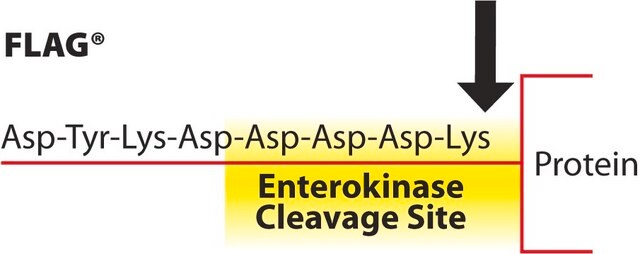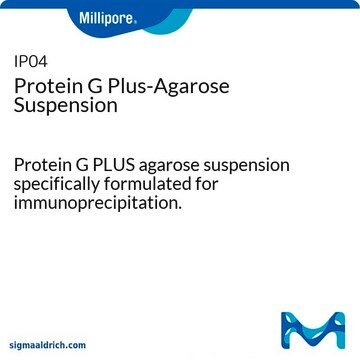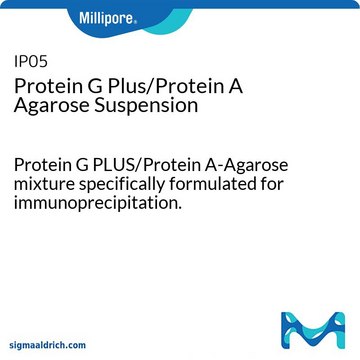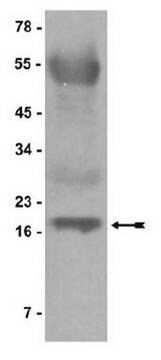PROTGA-RO
Roche
Protein G Agarose
>98% (HPLC and SDS-PAGE), suspension
Synonyme(s) :
agarose, protein g
Se connecterpour consulter vos tarifs contractuels et ceux de votre entreprise/organisme
About This Item
Code UNSPSC :
41116133
Produits recommandés
Essai
>98% (HPLC and SDS-PAGE)
Forme
suspension
Conditionnement
pkg of 15 mL (05015952001 [settled resin volume])
pkg of 2 mL (11719416001 [settled resin volume])
pkg of 5 mL (11243233001 [settled resin volume])
Fabricant/nom de marque
Roche
Température de stockage
2-8°C
Description générale
Protein G was initially isolated from G148, a human group G Streptococcal strain. It is a cell wall protein and shows high affinity to IgG (immunoglobulin G). It has a putative molecular weight of 30,000Da. It interacts with all subclasses of human IgG and also binds to mouse, rabbit and goat IgG.
Spécificité
Protein G is a cell wall protein, isolated from a specific bacterial strain, which has specific binding sites for certain classes of immunoglobulins from different species. Protein G binds nearly all subclasses of IgG, but no other classes of immunoglobulins.
Binding capacity: 20mg human IgG (polyclonal)/ml (the IgG is loaded at pH 7.0, and eluted with 200mM glycine, pH 2.8)
Structure: recombinant Protein G (E. coli, Mr = 22,000) is covalently coupled to crosslinked 4% agarose beads: 2.5mg Protein G (>98% pure)/1ml gel.
Binding capacity: 20mg human IgG (polyclonal)/ml (the IgG is loaded at pH 7.0, and eluted with 200mM glycine, pH 2.8)
Structure: recombinant Protein G (E. coli, Mr = 22,000) is covalently coupled to crosslinked 4% agarose beads: 2.5mg Protein G (>98% pure)/1ml gel.
Application
Affinity chromatography using Protein G Agarose, like Protein A Agarose, is the method of choice for purification of IgG from many species. It has been used as a pre-clearing agent during-
- Ubiquitination assay
- Immunoprecipitation
Caractéristiques et avantages
Contents
Preswollen gel, ready-to-use, 2ml or 5ml gel (settled gel volume) in buffer that contains 14-19% ethanol as a preservative, nonsterile.
Protein G content: 2.5mg/ml preswollen gel
Preswollen gel, ready-to-use, 2ml or 5ml gel (settled gel volume) in buffer that contains 14-19% ethanol as a preservative, nonsterile.
Protein G content: 2.5mg/ml preswollen gel
Qualité
Purity: >98% (HPLC, SDS-PAGE); entirely free from staphylococcal enterotoxins.
Autres remarques
For life science research only. Not for use in diagnostic procedures.
Mention d'avertissement
Warning
Mentions de danger
Conseils de prudence
Classification des risques
Eye Irrit. 2 - Flam. Liq. 3
Code de la classe de stockage
3 - Flammable liquids
Classe de danger pour l'eau (WGK)
WGK 1
Point d'éclair (°F)
102.2 °F
Point d'éclair (°C)
39 °C
Faites votre choix parmi les versions les plus récentes :
Déjà en possession de ce produit ?
Retrouvez la documentation relative aux produits que vous avez récemment achetés dans la Bibliothèque de documents.
Les clients ont également consulté
Yijiao Ning et al.
Frontiers in oncology, 12, 937716-937716 (2022-10-18)
Aberrant protocadherins (PCDHs) expression trigger tumor invasion and metastasis. PCDH20 anti-tumor functions in various tumor have been identified. Tumor suppression is due to Wnt/β-catenin pathway antagonism and may be suppressed caused by PCDH20 downregulation through promotor methylation, whereas PCDH20 effects
Jakob Triebel et al.
European journal of endocrinology, 161(2), 345-353 (2009-05-30)
In vitro experiments and in vivo studies on rodents demonstrate that N-terminal 14, 15, 16, 17, and 18 kDa fragments prolactin-related vasoinhibin (PRL-V) of human PRL are natural inhibitors of neovascularization in the retina and elsewhere. These N-terminal PRL fragments
T-H Kim et al.
Cell death & disease, 5, e1527-e1527 (2014-11-21)
Understanding the molecular networks that regulate adipogenesis is crucial for combating obesity. However, the identity and molecular actions of negative regulators that regulate the early development of adipocytes remain poorly understood. In this study, we investigated the role of CREB3L4
R Travis Taylor et al.
Methods (San Diego, Calif.), 55(2), 166-171 (2011-08-23)
Ubiquitin (Ub) conjugation to a substrate protein is a widely used cellular mechanism for control of protein stability and function, modulation of signal transduction pathways and antiviral responses. Identification and characterization of ubiquitinated viral proteins is an important step in
L Björck et al.
Journal of immunology (Baltimore, Md. : 1950), 133(2), 969-974 (1984-08-01)
Protein G, a bacterial cell wall protein with affinity for immunoglobulin G (IgG), has been isolated from a human group G streptococcal strain (G148). Bacterial surface proteins were solubilized by enzymatic digestion with papain. Protein G was isolated by sequential
Notre équipe de scientifiques dispose d'une expérience dans tous les secteurs de la recherche, notamment en sciences de la vie, science des matériaux, synthèse chimique, chromatographie, analyse et dans de nombreux autres domaines..
Contacter notre Service technique















